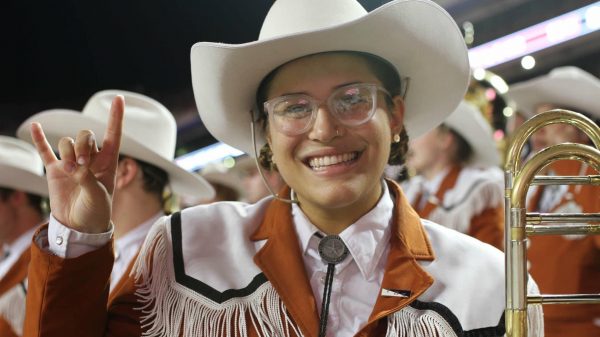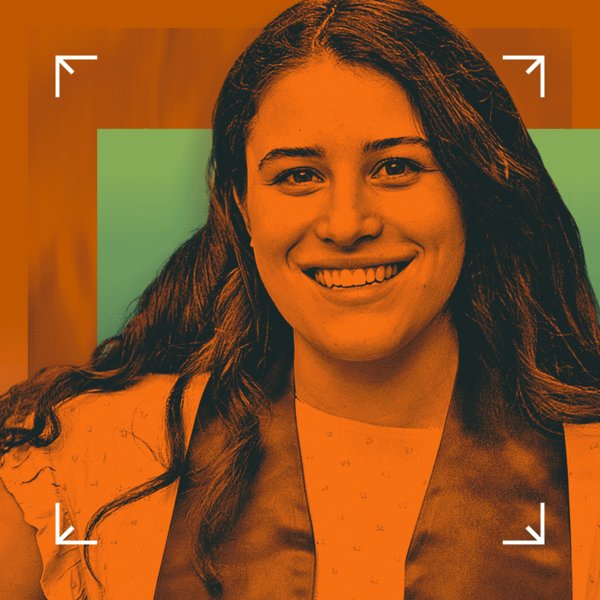Mia Stanley’s favorite UT memories are small moments: sitting on campus while birds chirp in the background; admiring the grass and trees, a welcome change of scenery from the desert of Odessa, her hometown in West Texas; and meeting people she wouldn’t have met otherwise.
Stanley says of her best friend, whom she met through Longhorn Band: “She’s from North Carolina. … I think of the weird off chance that she chose to play the saxophone in the sixth grade and the weird off chance that I chose to play the trombone in seventh grade — and the circuitous routes that it took for us to meet.”
Stanley, who joined Longhorn Band as a trombone player her freshman year and became a section leader her junior year, says that her involvement with the organization made The University of Texas at Austin feel less overwhelming. While at one of the nation’s largest universities, Stanley says, the Longhorn Band’s rigorous four-day-a-week schedule and 35-person trombone section were “centering.”

One of our outstanding seniors from the 2021 class, Stanley will graduate this spring with a bachelor’s degree in art history. She is the recipient of a Longhorn Alumni Band General Scholarship; a Willie Nelson Endowed Presidential Scholarship; and a John F. Newnam Endowed Presidential Scholarship in Art History. She works as a student development assistant for the College of Fine Arts and is an undergraduate research assistant for Janice Leoshko, associate professor of art history and South Asian art.
Stanley’s parents instilled her appreciation of art from a young age. She grew up visiting art museums and worked as an intern at the Ellen Nöel Art Museum in Odessa, where her mother is a museum education coordinator; her father is a ceramics professor. Given her interest in art, she had initially considered attending a small liberal arts college. But with the rigor of her classes and Austin’s pleasant weather and landscape — including the Forty Acres she finds beautiful — she realized that she made the right decision by enrolling at UT.
Her sophomore year, she served as a First-Year Interest Group (FIG) mentor to a class of 15 undeclared students. Each week, she shared campus resources and scheduled faculty and staff guest speakers to prepare the students as they transferred into the McCombs School of Business, Cockrell School of Engineering and Moody College of Communication. Stanley, who still keeps in touch with some of the students, says serving as a mentor was a learning experience that allowed her to observe her group’s growth over the course of the year — and through the role, she gained a boost in confidence.
“There’s the expectation that if you go to a state school, it won’t be as challenging as an Ivy League. That is not true at all. There are such brilliant students here,” she says.
Stanley is also an Arabic minor, which has led her to study the ancient architecture of the Middle East. She received an undergraduate research grant for her honors thesis analyzing the Rosetta Stone (part of an ancient Egyptian stone with a message in three languages, which led to the understanding of hieroglyphs), the decipherment of ancient Mayan languages and the history of inscription in Iran. Her thesis addresses epigraphy, which is the study of inscriptions, and reception theory, which studies how the interpretation of objects changes over time.
“I think we have this obsession with languages. It’s an integral thing to humanities, and art history is a really interesting field because it’s based on lots of different principles,” Stanley says, adding that the credit for people who have held the power to define what languages are — such as in the case of who “discovered” Egyptian hieroglyphs — is changing. “A really interesting change that’s happening is, more historians are focusing on the more complex story that hasn’t been told.”
Stanley, who considers herself a social person, says that adjusting to the pandemic was challenging because it reduced interaction and forced her to stay home. She missed being able to see artwork up close and in greater detail as she could before her classes moved to remote learning. She says one silver lining of the pandemic is that many arts institutions have made resources such as online programming more accessible to the public.
Pointing to the many pieces of artwork on her walls, Stanley says she appreciates how art history reflects the importance of visual literacy. She learned that over the past several hundred years, and particularly in a digital age, the number of images that each person views in a lifetime has increased rapidly. She says that art history has also helped her develop critical thinking and writing skills, which she will use after graduation in her full-time position as a development associate supporting the major gifts team at Dell Medical School.
“While I like to plan things, something I have gained throughout college is: I’m OK with not knowing what life is going to look like. But getting this position at Dell Med has brought me peace because it’s a place where I see myself growing,” she says, adding that she looks forward to promoting access to health care — and sitting in on a lunchtime art history lecture down the street.
For future students, Stanley has this advice: “There are opportunities that you have to create for yourself. There’s a wealth of resources at this school that you have to dig for, but they are there, and they can help you. The greatest thing that I’ve learned at UT is just how helpful individual people are. It’s a huge institution. They’re trying to help as many people as they can, but if you reach out to individual people and ask for help, my experience has been that they are going to help you.”
